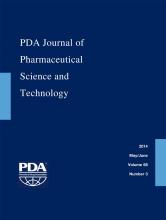Research ArticleResearch
The Use of TOC Reconciliation as a Means of Establishing the Degree to Which Chromatographic Screening of Plastic Material Extracts for Organic Extractables Is Complete
Dennis Jenke, Thomas R. Couch, Sarah J. Robinson, Trent J. Volz and Raymond H. Colton
PDA Journal of Pharmaceutical Science and Technology May 2014, 68 (3) 256-270; DOI: https://doi.org/10.5731/pdajpst.2014.00977
Dennis Jenke
1Baxter Healthcare Corporation, Round Lake, IL and
Thomas R. Couch
1Baxter Healthcare Corporation, Round Lake, IL and
Sarah J. Robinson
2VR Analytical, LLC, Bend, OR
Trent J. Volz
2VR Analytical, LLC, Bend, OR
Raymond H. Colton
2VR Analytical, LLC, Bend, OR

References
- 1.↵
- Ball D. J.,
- Norwood D. L.,
- Stults C. L. M.,
- Nagao L. M.
- Paskiet D.,
- Lippert E. L.,
- Mitchell B. D.,
- Zurbriggen D.
- 2.↵
- Jenke D.
- 3.↵
Guidance for Industry. Container Closure Systems for Packaging Human Drugs and Biologics. U.S. Department of Health and Human Services, Food and Drug Administration: Rockville, MD, May 1999.
- 4.↵
Guideline on Plastic Immediate Packaging Materials. European Medicines Agency. CPMP/QWWP/4359/03. EMEA/CVMP/205/04. 5/19/05.
- 5.↵
ANSI/AAMI BE3:2006. Biological evaluation of medical devices—Part 18: Chemical characterization of materials. AAMI: Arlington, VA, March 21, 2006.
- 6.↵
Product Quality Research Institute (PQRI) Leachables and Extractables Working Group. Safety Thresholds and Best Practices for Extractables and Leachables in Orally Inhaled and Nasal Drug Products; Product Quality Research Institute: Arlington, VA, 2006; available at http://www.pqri.org/pfds/LE-Recommendations-to-FDA-09-29-06.pdf. See, for example, pp 108–117.
- 7.↵
- Martin J.,
- Fitzgerald R.,
- Pothier N.,
- Ding W.
- 8.↵
- Tribon V.,
- Creasey J.
- 9.↵
Chapter <643> Total Organic Carbon. In USP 36/NF 31; United Sates Pharmacopeial Convention: Rockville, MD, 2013; p 276.
- 10.↵
- Jenke D.,
- Poss M. P.,
- Sadain S.,
- Story J.,
- Smith W.,
- Reiber D.
- 11.↵
- Nashed-Samuel Y.,
- Torraca G.,
- Liu D.,
- Fujimori K.,
- Zhang Z.,
- Wen Z.,
- Lee H.
- 12.↵
- Yu X.,
- Zdravkovic S.,
- Wood D.,
- Li C.,
- Cheng Y.,
- Ding X.
- 13.↵
- Azuma K.,
- Hirata T.,
- Tsunoda H.,
- Ishitani T.,
- Tanaka Y.
- 14.↵
- Azuma K.,
- Tanaka Y.,
- Tsunoda H.,
- Hirata T.,
- Ishitani T.
- 15.↵
- Buchalla R.,
- Boess C.,
- Bogl K. W.
- 16.↵
- Buchalla R.,
- Boess C.,
- Bogl K. W.
- 17.↵
- 18.↵
- Kao Y. H.,
- Bender J.,
- Hagewiesche A.,
- Wong P.,
- Huang Y.,
- Vanderlaan M.
- 19.↵
In This Issue
PDA Journal of Pharmaceutical Science and Technology
Vol. 68, Issue 3
May/June 2014
The Use of TOC Reconciliation as a Means of Establishing the Degree to Which Chromatographic Screening of Plastic Material Extracts for Organic Extractables Is Complete
Dennis Jenke, Thomas R. Couch, Sarah J. Robinson, Trent J. Volz, Raymond H. Colton
PDA Journal of Pharmaceutical Science and Technology May 2014, 68 (3) 256-270; DOI: 10.5731/pdajpst.2014.00977
The Use of TOC Reconciliation as a Means of Establishing the Degree to Which Chromatographic Screening of Plastic Material Extracts for Organic Extractables Is Complete
Dennis Jenke, Thomas R. Couch, Sarah J. Robinson, Trent J. Volz, Raymond H. Colton
PDA Journal of Pharmaceutical Science and Technology May 2014, 68 (3) 256-270; DOI: 10.5731/pdajpst.2014.00977
Jump to section
Related Articles
- No related articles found.
Cited By...
- Identifying and Mitigating Errors in Screening for Organic Extractables and Leachables: Part 1--Introduction to Errors in Chromatographic Screening for Organic Extractables and Leachables and Discussion of the Errors of Omission
- Using Extractables Data of Sterile Filter Components for Scaling Calculations
- Comparative Extractables Study of Autoclavable Polyethersulfone Filter Cartridges for Sterile Filtration
- Extractables Screening of Polypropylene Resins Used in Pharmaceutical Packaging for Safety Hazards
- Creating a Holistic Extractables and Leachables (E&L) Program for Biotechnology Products





